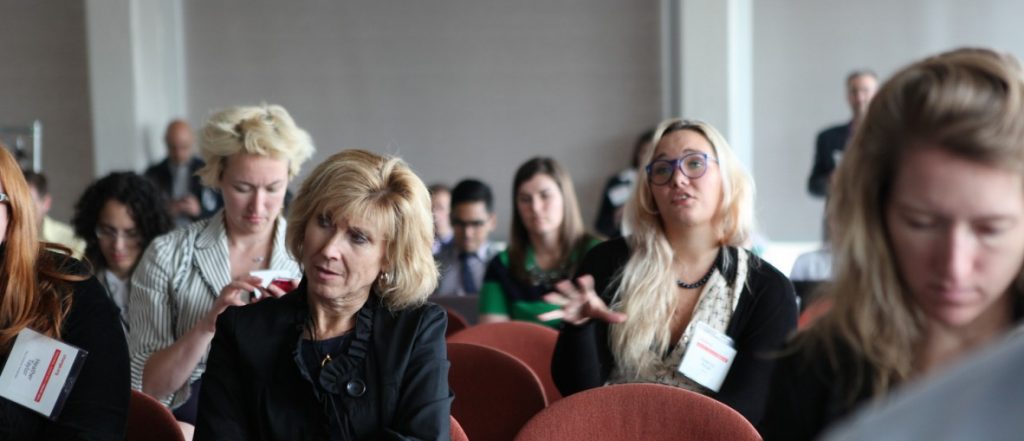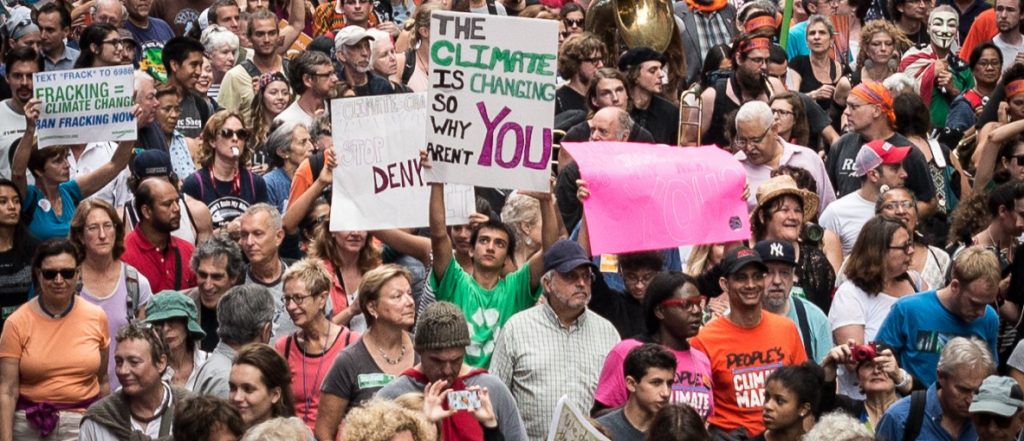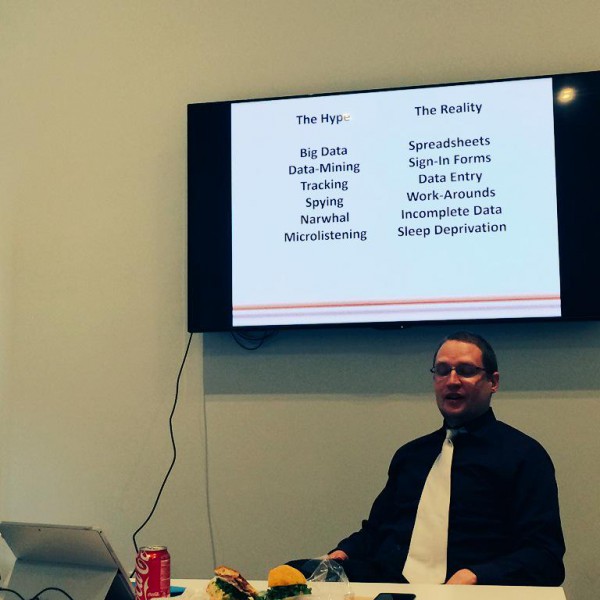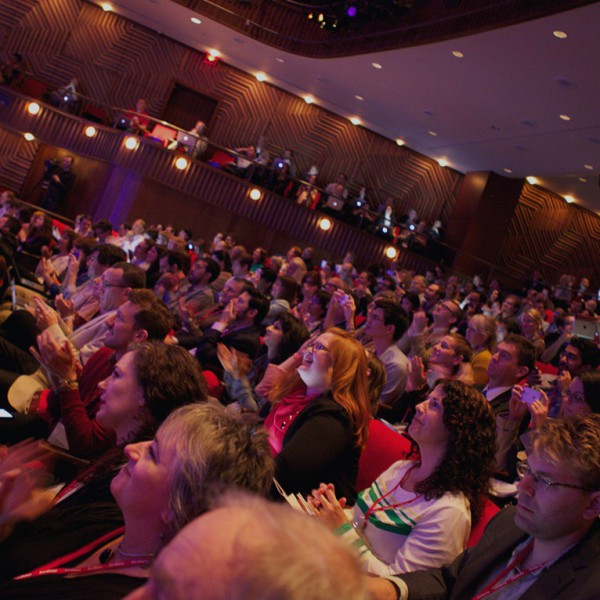The People’s Climate March last fall in New York City was a monumental feat of organizing prowess. Seasoned environmentalists from big-budget nonprofits worked with grassroots activists from scrappy community-based groups to pull together the largest environmental demonstration in history. The motto “To change everything, we need everyone” was prominently displayed on the homepage of PeoplesClimate.org. To encourage inclusivity, the international environmental group 350.org hired a contractor to implement an online platform that supported decentralized network organizing. The platform was an important tool for getting people, especially those outside New York City, to the march. It made it easy for anyone to participate, even if they were not a member of a big environmental group, through a system of “hubs” that invited people to join based on geographic-, religious-, community-, or issue-based identities. However, after the march was over—after the headlines had been made—financial, technical, and administrative support for the hubs ended, in spite of declarations that the march would be “about more than just a single day.”

(South Bend Voice/Flickr, CC BY-SA 2.0)
When I first wrote about the People’s Climate March last fall, Tammy Shapiro, the person contracted by 350.org to oversee organizing on the hubs platform, said she hoped that it would stay online after the march as a resource for future climate change activism. Shapiro had worked on an earlier iteration of the hubs platform called InterOccupy, and saw the critical part it had played in Occupy Sandy, even after Occupy Wall Street had allegedly “died.” Shapiro hoped that the hubs platform could be a similar springboard for climate actions post-march.
Technically, the hubs platform is still online. The hubs are still listed; at least a few are still active. However, the link to start a new hub is broken, and if hub coordinators run into a problem, technical or otherwise, there is nobody responsible for assisting them.

Clicking on the link to start a new hub takes you here.
Phil Aroneanu, a co-founder of 350.org, and Matt Leonard, 350.org’s director of special projects, point out that march organizers, including 350.org, never intended to create a new “People’s Climate” organization; it was a temporary coalition brought together by the powerful idea of putting on the largest climate demonstration in history. The hubs were, by their account, meant to be similarly short-lived. But even if it was not 350.org’s responsibility to support the hubs indefinitely (although they are covering the costs of keeping PeoplesClimate.org online), opting out of them was a missed opportunity. If the march was really about “action, not words,” dismantling infrastructure that could support that work—by neglect at least, if not intentional disassembly—is the last thing an environmental organization trying to support a movement would want to do.

A PLACE AT THE TABLE
To be clear, we are not talking about a particularly high-tech platform. The default hub homepage prompted coordinators to describe each hub’s mission (for example, the Skaters wanted to “roll forward with real progress on climate action”). Each hub had buttons for people to join its listserv, to RSVP to the march, to join a Facebook group, and a space for a blog. Funding for the hubs also covered MaestroConference calls. But however simple, the hubs were also highly customizable. Hub coordinators took advantage of this to varying degrees. Compare, for example, the People’s Climate Art and the Nuclear-Free Carbon-Free hubs with the more bare-bones hubs for Canadians and Workers.

A basic hub page for Climate Literacy.
What made the hubs unique was that they were set up to facilitate organizing free of organizational ties. In the run-up to the march, an anti-fracking group asked Shapiro to create a hub for them, but she refused and suggested they start a generic anti-fracking hub instead. There is no hub for Greenpeace or the Sierra Club, but there are hubs for Pagans, Beekeepers, Anti-Capitalists, Grad Students for Climate Justice, and the Deep South.
Christopher Wahmhoff, a hub coordinator from Kalamazoo, Michigan, believes the platform “forced large NGOs to play a hand with the small guys.” After the 2010 oil spill in the Kalamazoo River, Wahmhoff recalls that all of the big environmental organizations used the disaster to ask for donations, without coordinating with local groups. “We never really got to have a voice in our own oil spill,” he tells Civicist.
But in the run-up to the march Wahmhoff says, “We got to sit at the same table.”
In a nearly 10,000-word post-mortem on the hubs, provided to Civicist, Tammy Shapiro notes that some of the hub coordinators were members of national nonprofits that found the hub system “more inclusive, diverse, and connected than their individual organizations.”
The Maryland hub coordinator, and a Sierra Club organizer, Seth Bush, reported that, “The hubs were an opportunity to work past the traditional Sierra Club folks, and bring in more people from more diverse areas. We want a forum that is connecting all of these [regional] groups in a sustainable way that isn’t just ‘Sierra Club’s organizational motives’ but more creative and from the bottom up.”
“Hubs provided a really great front door for unaffiliated people to come into the movement and find their people, people they didn’t know previously,” says Gan Golan, an artist and activist who studies decentralized network organizing with Shapiro at the Movement Net Lab. Golan was involved in the arts mobilization for the march.
“When you start to create self-organizing on the basis of people’s self-affinity,” Golan adds, “that is a solid bedrock…people want to maintain those connections.”

The Faith contingent at the People’s Climate March. (Peter Bowden)
“NOT A PARTICULARLY MEANINGFUL INVESTMENT TO EXIST IN PERPETUITY”
“Traditionally a lot of big products from the environmental movement come from very defined coalitions,” Matt Leonard, 350.org’s product manager for the march, tells Civicist. “We very intentionally wanted to make the People’s Climate March bigger than that.” Implementing the hubs system was one of the ways 350.org and other march organizers tried to make the march more inclusive.
Leonard says that the idea of the hubs was “met with a lot of skepticism” within 350.org. “[But] the ones of us who did have a background in grassroots organizing did push for this,” he adds.
(Back during the planning period for the march, Shapiro and her colleagues at Movement Net Lab pitched the hubs to march leadership as part of a larger suite of organizing strategies and tools. Although their ideas were not incorporated in their entirety, Shapiro and her colleagues, including Golan, were hired as individuals by different parts of the march organizing body.)
As for what happened to the hubs after the march, Leonard says, “Understandably, some of them dissolved,” citing a lack of motivation to continue organizing.
However, Leonard confirmed to Civicist that it was a deliberate decision to not give centralized support to the hubs post-march.
Phil Aroneanu, a co-founder of 350.org, tells Civicist that the hubs worked because people had a common goal: “Everybody knew what their job was which was to get their people out [to the march].”
Although Aroneanu did not exactly disparage the value of the hubs, he did not lavish the platform with praise, saying, “The hubs are one of many ways that people got engaged in the climate march.”
He adds:
One of the issues that we run into a lot, especially in digital organizing, [is]: ‘let’s just put a platform out there and see if people come to it and organize themselves.’ As a traditional organizer, I find that to be a crazy idea. People don’t join a network just to join a network.
Aroneanu says that the hubs worked well in places with little pre-existing organizing, like Syracuse, New York, but were less effective in cities like Washington, D.C., where activists had already worked together.
“Hubs are one of the ways that…certain kinds of people can get involved and feel like they have agency in the work,” Aroneanu says. At another point in our conversation he makes clear that he means “entrepreneurial” types.
But Aroneanu returns to the idea that the platform worked because everyone had something to work for, explaining that the “self-organizing space is most useful when there is a common goal across the network.”
It is “not a particularly meaningful investment to exist in perpetuity,” he tells Civicist.
However, Shapiro’s review of the hubs platform, which incorporated feedback from 42 individual hubs through a group call, a post-march survey, and one-on-one interviews, found that coordinators did want to continue using the hubs, for various reasons.
“MOBILIZE AT A HAT DROP”
Frank Regan was the hub coordinator for Western New York, in addition to being the former chair of the Rochester Sierra Club. In the process of organizing people to attend the climate march, he helped form the Rochester People’s Climate Coalition (RPCC), which was made up of more than 30 groups.
 “If you know anything about Rochester,” he tells Civicist, “[that’s] really unusual.”
“If you know anything about Rochester,” he tells Civicist, “[that’s] really unusual.”
In the run-up to the march, Regan invited local media outlets to come to a press conference the coalition held about the importance of the People’s Climate March, but only one media outlet showed. So Regan videotaped it himself and used the hubs to post the clip and a write-up.
“I think it’s a fantastic idea to become the media because the media is doing a terrible job,” he tells Civicist. He wanted the hubs platform to be a place “to become the media” and expressed his disappointment that the hubs are “kind of petering out.”
Still, the Western New York hub is one of those that has not petered out entirely; last month Regan used it to promote the first major event held by the RPCC, Earth Week.
Of the 23 coordinators who responded to a survey Tammy Shapiro sent out after the march, Regan was one of 11 coordinators who told her that they planned on using the hub after the march; eight others said they might use it.
The anti-nuclear hub told Shapiro that they would like to continue using the hub so “when big climate or nuclear moments come up they can mobilize at a hat drop.”
This response alone makes a strong argument for maintaining the hubs. Hub coordinators put time, effort, and energy into forging connections between groups and individuals who share a community, identity, or passion. It’s not clear why a movement organization, like 350.org, would want to let those groups go fallow, only to do all that work again the next time consensus and strength in numbers is needed.
Attempting to answer this question, Gan Golan tells Civicist:
Generally speaking, political parties and campaign organizations can feel threatened by autonomous organizing and can sometimes be hesitant to encourage the base to start organizing on their own terms…part of that is a fear of crazies but also a lack of faith that there is as much intelligence in the base as in the organizations.
“SO MANY MOVING PIECES”
The hubs system was not flawless; far from it. Shapiro herself catalogues a long list of problems and places the platform fell short. Hub coordinators, once self-selected, were all-but-impossible to oust (although you could add coordinators if someone fell off the map entirely), and there was no accountability system to ensure they were doing their job well. The platform was not set up to easily share information between hubs, so it was hard for coordinators to organize solidarity efforts with other hubs; it was also hard for hub coordinators to find and contact specific individuals. Because the various tools incorporated into the hubs platform were not integrated well, coordinators had to post updates and information separately in each forum (Facebook, Google Group, blog, etc.).

A partial list of hubs.
But the main problem, Shapiro tells Civicist, was a lack of organizing capacity. And hub coordinators felt it. Christopher Wahmhoff, the coordinator from Kalamazoo, told Civicist that although the hubs platform was like a “candyland of organizing,” that he felt like he “didn’t have enough energy to take advantage…[of] so many moving pieces.”
With more time (the hubs got off the ground just two months before the march) and support staff (“it was really just me,” Shapiro says), Shapiro could have worked more with coordinators to ensure that they knew how to best leverage the tools at their disposal. As it was, Shapiro could barely keep up with the requests to form hubs. They launched the platform with a backlog of requests and struggled to keep up as more flowed in.
When asked what she would have done differently with more time and resources, Shapiro says:
So many things. I would have started a lot earlier. I would have built a different system that had a front page that could pull in information from…the whole network. I would have been more intentional about finding coordinators and working more with existing coordinators. I would have integrated the hubs more with the rest of organizing.
When asked to elaborate, she says that the hubs were viewed as a someth
ing apart from other mobilizing strategies, instead of something meant to be integrated into the entire effort.
Finally, she says she would have a larger staff, saying at bare minimum you need a tech person, an administrator, and an organizer, “and we only had me and it was not good.”
MISSED OPPORTUNITIES
Shapiro says that failing to invest more in the hubs was not the only post-march failure: “There was lots of organizing and infrastructure that we created for the march that wasn’t maintained.”
Shapiro says that the point of a big event like the march is to rally supporters and like-minded people and then channel that energy into another event, another action; into a movement.

Screenshot of 350.org’s homepage, featuring the global climate movement.
She continues:
While the organizations that helped plan the march were able to build off that momentum in their own organizing, there were a lot of people who participated in the march who weren’t a part of one of those organizations and they didn’t necessarily have a way to participate after. The hubs could have been one of the answers but there were other answers as well that weren’t necessarily used.
In a follow-up email to Civicist, Phil Aroneanu explained that after the march “there was literally no more money to spend—all of the resources raised by various organizations had been used to mobilize towards the march.” The question is, if the march was about powering a movement, why didn’t the organizing parties set aside resources for sustaining that movement post-march?
What happened to the hubs platform makes clear that there is a need for tools and platforms to support and build movements that exist outside of traditional organizations, free from funding whims and windfalls or lack thereof. But it also underscores the fact that these tools will need administrators and facilitators. If there is one thing everyone I spoke to for this story could agree on, it is that you can’t just build it and expect them to come.
In a follow-up piece, Civicist will report on the work Shapiro, Golan and others are doing at Movement Net Lab studying and designing organizing strategies and other tools to support decentralized network movements, and on the Lab’s partnership with the Black Lives Matter movement.











 “If you know anything about Rochester,” he tells Civicist, “[that’s] really unusual.”
“If you know anything about Rochester,” he tells Civicist, “[that’s] really unusual.”




